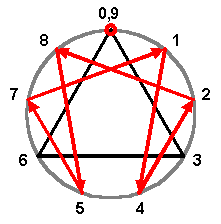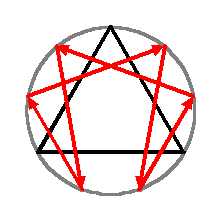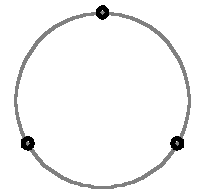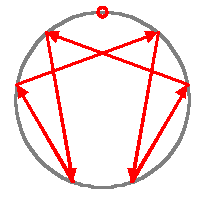N-Grams is my term for a geometric representation of the mathematics implied in the enneagram. The enneagram is a figure that came into European consciousness in the early 20th century. G. I. Gurdjieff is the person most often associated with its introduction. One of his students, John Bennett, incorporated it into a discipline he named Systematics. Tony Blake's book, The Intelligent Enneagram, follows in this tradition. The enneagram has also been used in theories of personality and body-types. This work is in the tradition of Systematics and not personality or body-type theory.
Mathematics of the Enneagram


Enneagram
The enneagram (shown above, with and without the numbers each point represents) has three parts - the outer circle (which could be said to represent the numeric base containing the patterns), a triangle (in black above), and a six-pointed figure (in red above) sometimes drawn with arrows, sometimes with plain lines. The mathematical basis of the enneagram is the repeating digit-patterns of 1/3 and 1/7 in base ten. The red arrowed lines reflect division by 7. The repeating digit pattern 1-4-2-8-5-7-1 occurs in the decimal representation for 1/7, 2/7, 3/7, 4/7, 5/7, and 6/7, varying only with the starting digit (e.g., 2/7 = 0.2857142857..., 6/7 = 0.857142857...). The black triangle ties together the three points involved in division by 3. The three points come from the decimal representations 0/3 = 0.000..., 1/3 = 0.333..., 2/3 = 0.666..., and 3/3 = 0.999... . Note that 0/3 and 3/3 are both represented by the top point. It also represents 0/7 and 7/7.
Following a talk Tony Blake gave some years ago I explored enneagram-like figures in bases other than ten. From that I generalized the enneagram-like patterns that result from division by an integer in a larger integral base. I call the pattern formed from one divisor (here, 3 or 7) and a specific numeric base (here, ten) an "atomic" N-Gram. I split the enneagram into its two parts to make it easier to distinguish some details - for instance, that the top point should be included in both the N-Grams comprising the enenagram (as per the following diagrams). Rather than using the traditional triangle for representing division by 3, I use 3 distinct points, since that more closely reflects the numeric patterns formed (see the last paragraph).


(Atomic) N-Grams, division by 3 and by 7 in base ten